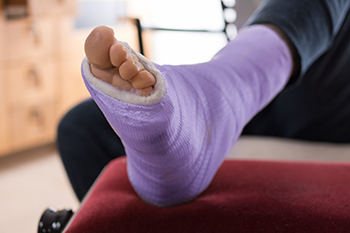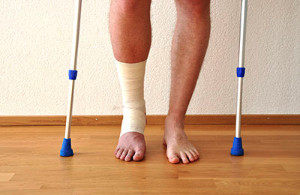Items filtered by date: August 2023
How High Heels Impact Feet

High heels, while undoubtedly stylish, come with a hidden price tag that affects our feet, which are the foundation of our body. These chic yet often uncomfortable footwear choices can lead to a cascade of issues. The elevated heel forces the body's weight forward, disrupting the natural alignment of the spine, possibly causing lower back pain. Additionally, toes are crammed into tight spaces, and may lead to deformities such as bunions and hammertoes. The lack of proper arch support strains the feet's ligaments and tendons, contributing to plantar fasciitis and Achilles tendonitis. Prolonged wear can result in shortened calf muscles, impacting overall gait and stability. Recognizing how wearing high heels can negatively affect the feet may cause an individual to try different footwear. If you would like more information about the effects high heels can have on the feet, it is suggested that you speak with a podiatrist who can address any questions or concerns you may have.
High heels have a history of causing foot and ankle problems. If you have any concerns about your feet or ankles, contact Shawn Echard, DPM from Laurel Podiatry LLC. Our practitioner can provide the care you need to keep you pain-free and on your feet.
Effects of High Heels on the Feet
High heels are popular shoes among women because of their many styles and societal appeal. Despite this, high heels can still cause many health problems if worn too frequently.
Which Parts of My Body Will Be Affected by High Heels?
- Ankle Joints
- Achilles Tendon – May shorten and stiffen with prolonged wear
- Balls of the Feet
- Knees – Heels cause the knees to bend constantly, creating stress on them
- Back – They decrease the spine’s ability to absorb shock, which may lead to back pain. The vertebrae of the lower back may compress.
What Kinds of Foot Problems Can Develop from Wearing High Heels?
- Corns
- Calluses
- Hammertoe
- Bunions
- Morton’s Neuroma
- Plantar Fasciitis
How Can I Still Wear High Heels and Maintain Foot Health?
If you want to wear high heeled shoes, make sure that you are not wearing them every day, as this will help prevent long term physical problems. Try wearing thicker heels as opposed to stilettos to distribute weight more evenly across the feet. Always make sure you are wearing the proper shoes for the right occasion, such as sneakers for exercising. If you walk to work, try carrying your heels with you and changing into them once you arrive at work. Adding inserts to your heels can help cushion your feet and absorb shock. Full foot inserts or metatarsal pads are available.
If you have any questions please feel free to contact our offices located in Greensburg and Somerset, PA . We offer the newest diagnostic and treatment technologies for all your foot and ankle needs.
Common Causes of a Broken Ankle

A broken ankle, a distressing and often unexpected injury, can significantly disrupt daily life. Numerous factors can lead to this type of fracture, reminding us of the intricate vulnerability of our feet. Accidents and falls are among the primary culprits, especially when landing awkwardly or with force. High impact sports and activities, marked by sudden twists or impacts, also pose a risk. Osteoporosis is a medical condition that can weaken bones, making them more susceptible to fractures from even minor impacts. Recognizing these triggers is crucial for preventing broken ankles. Employing protective gear, wearing proper footwear, and implementing cautious movement can collectively contribute to foot safety. A broken ankle is painful and generally happens immediately. If you have endured this type of injury, it is suggested that you confer with a podiatrist who can effectively diagnose and treat a broken ankle.
Broken ankles need immediate treatment. If you are seeking treatment, contact Shawn Echard, DPM from Laurel Podiatry LLC. Our practitioner can provide the care you need to keep you pain-free and on your feet.
Broken Ankles
A broken ankle is experienced when a person fractures their tibia or fibula in the lower leg and ankle area. Both of these bones are attached at the bottom of the leg and combine to form what we know to be our ankle.
When a physician is referring to a break of the ankle, he or she is usually referring to a break in the area where the tibia and fibula are joined to create our ankle joint. Ankles are more prone to fractures because the ankle is an area that suffers a lot of pressure and stress. There are some obvious signs when a person experiences a fractured ankle, and the following symptoms may be present.
Symptoms of a Fractured Ankle
- Excessive pain when the area is touched or when any pressure is placed on the ankle
- Swelling around the area
- Bruising of the area
- Area appears to be deformed
If you suspect an ankle fracture, it is recommended to seek treatment as soon as possible. The sooner you have your podiatrist diagnose the fracture, the quicker you’ll be on the way towards recovery.
If you have any questions, please feel free to contact our offices located in Greensburg and Somerset, PA . We offer the newest diagnostic and treatment technologies for all your foot care needs.
Nurturing Diabetic Feet with Knowledge and Caution

Proper foot care is of utmost importance for individuals with diabetes, as they are more susceptible to foot complications. Diabetic neuropathy, a condition that impairs nerve function, can reduce sensation in the feet, making it challenging to detect injuries or infections. Regular foot inspections, daily washing with lukewarm water, and thorough drying are essential to maintaining foot health. Applying moisturizer to prevent dry skin and wearing shoes that fit well may help to prevent potential wounds. Trimming toenails straight across and avoiding sharp corners can reduce the risk of ingrown toenails. It's crucial to avoid walking barefoot in addition to inspecting shoes for foreign objects before wearing them. By incorporating these simple, yet vital, steps into their routine, individuals with diabetes can safeguard their foot health and minimize the risk of serious complications. If you have diabetes, it is strongly suggested that you are under the care of a podiatrist who can help you to manage this condition.
Diabetic foot care is important in preventing foot ailments such as ulcers. If you are suffering from diabetes or have any other concerns about your feet, contact Shawn Echard, DPM from Laurel Podiatry LLC. Our practitioner can provide the care you need to keep you pain-free and on your feet.
Diabetic Foot Care
Diabetes affects millions of people every year. The condition can damage blood vessels in many parts of the body, especially the feet. Because of this, taking care of your feet is essential if you have diabetes, and having a podiatrist help monitor your foot health is highly recommended.
The Importance of Caring for Your Feet
- Routinely inspect your feet for bruises or sores.
- Wear socks that fit your feet comfortably.
- Wear comfortable shoes that provide adequate support.
Patients with diabetes should have their doctor monitor their blood levels, as blood sugar levels play such a huge role in diabetic care. Monitoring these levels on a regular basis is highly advised.
It is always best to inform your healthcare professional of any concerns you may have regarding your feet, especially for diabetic patients. Early treatment and routine foot examinations are keys to maintaining proper health, especially because severe complications can arise if proper treatment is not applied.
If you have any questions please feel free to contact our offices located in Greensburg and Somerset, PA . We offer the newest diagnostic and treatment technologies for all your foot and ankle needs.
Causes and Effects of Morton’s Neuroma

Morton's neuroma is a painful condition that affects the nerves in the foot, specifically between the third and fourth toes. The causes of this condition can be attributed to various factors, such as wearing tight, narrow shoes that compress the toes as well as high heels which increase pressure on the forefoot. Additionally, Morton's neuroma may occur from performing repetitive activities that strain the nerves. Mild relief may be found when the shoes that are worn have a wide-toe box and low heels. Wearing specific types of orthotics may be beneficial in alleviating pain and redistributing pressure. Resting the affected foot as often as possible is important to promote healing. If symptoms persist, it is suggested that you contact a podiatrist for a proper diagnosis and a personalized treatment plan to effectively manage Morton's neuroma.
Morton’s neuroma is a very uncomfortable condition to live with. If you think you have Morton’s neuroma, contact Shawn Echard, DPM of Laurel Podiatry LLC. Our practitioner will attend to all of your foot care needs and answer any of your related questions.
Morton’s Neuroma
Morton's neuroma is a painful foot condition that commonly affects the areas between the second and third or third and fourth toe, although other areas of the foot are also susceptible. Morton’s neuroma is caused by an inflamed nerve in the foot that is being squeezed and aggravated by surrounding bones.
What Increases the Chances of Having Morton’s Neuroma?
- Ill-fitting high heels or shoes that add pressure to the toe or foot
- Jogging, running or any sport that involves constant impact to the foot
- Flat feet, bunions, and any other foot deformities
Morton’s neuroma is a very treatable condition. Orthotics and shoe inserts can often be used to alleviate the pain on the forefront of the feet. In more severe cases, corticosteroids can also be prescribed. In order to figure out the best treatment for your neuroma, it’s recommended to seek the care of a podiatrist who can diagnose your condition and provide different treatment options.
If you have any questions, please feel free to contact our offices located in Greensburg and Somerset, PA . We offer the newest diagnostic and treatment technologies for all your foot care needs.
We Can Treat Your Foot or Ankle Pain
Risk Factors and Types of Dislocated Ankles

The ankle joint is a structure of bones, ligaments, muscles, and tendons that allow the foot to flex and point. At this complex joint, the tibia and fibula muscles of the calf connect with the talus bone of the foot, forming what is termed the ankle mortise. These bones bear the majority of weight bearing, while the ligaments that hold them in place provide stability. When this mechanism fails, usually as the result of some kind of trauma, the ankle becomes dislocated. The most common causes of a dislocated ankle are falls, car accidents, and sports injuries. Types of dislocations include posterior, anterior, lateral, and superior. A posterior dislocation, which is the most common, occurs when the talus is pushed forward while the tibia is pushed backward. A lateral dislocation, which occurs when the ankle is twisted, is usually accompanied by a bone fracture. A superior dislocation occurs when the talus is pushed upward into the space between the tibia and fibula, often the result of a fall or car crash. Treatment for a dislocated ankle depends on the type and severity of the injury, and recovery can take up to 3 months. For help with an ankle dislocation, it is suggested that you make an appointment with a podiatrist.
Ankle pain can be caused by a number of problems and may be potentially serious. If you have ankle pain, consult with Shawn Echard, DPM from Laurel Podiatry LLC. Our practitioner will assess your condition and provide you with quality foot and ankle treatment.
Ankle pain is any condition that causes pain in the ankle. Due to the fact that the ankle consists of tendons, muscles, bones, and ligaments, ankle pain can come from a number of different conditions.
Causes
The most common causes of ankle pain include:
- Types of arthritis (rheumatoid, osteoarthritis, and gout)
- Ankle sprains
- Broken ankles
- Achilles tendonitis
- Achilles tendon rupture
- Stress fractures
- Bursitis
- Tarsal tunnel syndrome
- Plantar fasciitis
Symptoms
Symptoms of ankle injury vary based upon the condition. Pain may include general pain and discomfort, swelling, aching, redness, bruising, burning or stabbing sensations, and/or loss of sensation.
Diagnosis
Due to the wide variety of potential causes of ankle pain, podiatrists will utilize a number of different methods to properly diagnose ankle pain. This can include asking for personal and family medical histories and of any recent injuries. Further diagnosis may include sensation tests, a physical examination, and potentially x-rays or other imaging tests.
Treatment
Just as the range of causes varies widely, so do treatments. Some more common treatments are rest, ice packs, keeping pressure off the foot, orthotics and braces, medication for inflammation and pain, and surgery.
If you have any questions, please feel free to contact our offices located in Greensburg and Somerset, PA . We offer the newest diagnostic and treatment technologies for all your foot care needs.

